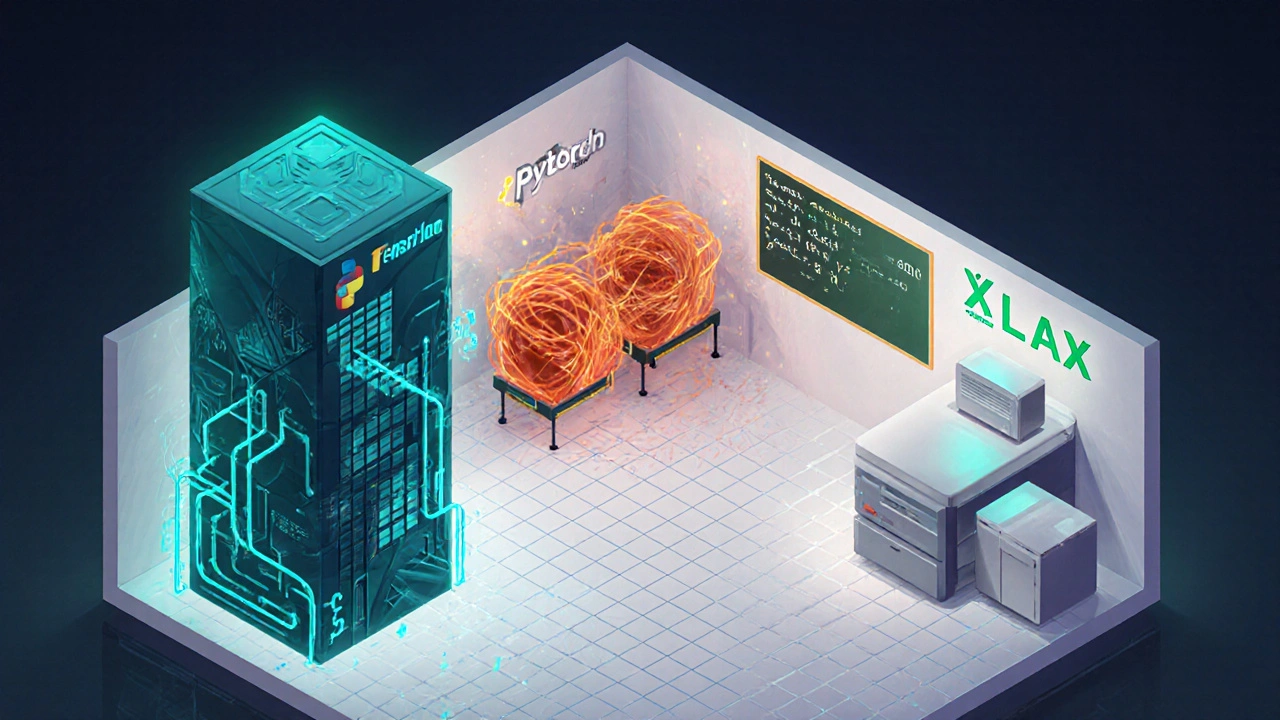How Python is Revolutionizing AI in 2025

AI Framework Comparison Tool
Choose Your Project Requirements
Select the criteria that matter most for your AI project to see which frameworks are best suited.
Recommended Frameworks
When you hear the phrase "AI breakthrough", the first thing most people picture is a shiny robot or a futuristic app. Behind that hype, however, lives a very human-friendly programming language that’s been quietly reshaping the field: Python is a high‑level, interpreted language known for its readability and massive ecosystem. Over the past decade, Python has moved from a handy scripting tool to the backbone of almost every major AI project. In this article we’ll explore why Python matters, which libraries drive the magic, and how the language is changing the game for researchers and developers alike.
From a Hobbyist Language to AI’s Mainstay
Python’s journey started in the late 1980s, but its rise in AI truly began in the early 2010s when deep‑learning frameworks started offering Python bindings. TensorFlow is an open‑source library developed by Google for building and training neural networks and PyTorch is a flexible, research‑focused framework created by Facebook AI Research both chose Python as their primary interface. That decision lowered the barrier to entry for students, startups, and even large enterprises, making it possible to prototype an idea in minutes instead of weeks.
Fast‑forward to 2025, Python now powers everything from self‑driving car perception stacks to massive language models like GPT‑4. The language’s simplicity lets engineers focus on algorithmic thinking rather than boilerplate code, a factor that’s directly linked to faster iteration cycles and more innovative products.
Why Python Became AI’s Favorite
- Readability: Clean syntax mirrors natural language, reducing bugs and making code reviews easier.
- Rich Ecosystem: Packages such as NumPy is a fundamental library for numerical computing with powerful n‑dimensional array objects and Pandas is a data‑analysis toolkit offering flexible data structures like DataFrames provide the building blocks for data preprocessing, while specialized libraries handle modeling.
- Community Support: Thousands of tutorials, Stack Overflow answers, and open‑source contributions keep the knowledge base fresh.
- Integration Friendly: Python talks easily to C/C++, Java, and GPUs, allowing performance‑critical sections to live where they belong while keeping the high‑level workflow in Python.
Core Libraries That Power Modern AI
Below is a quick rundown of the most influential Python packages in the AI sphere. Each library solves a specific part of the AI pipeline, from data ingestion to model deployment.
- scikit-learn is a versatile library for classical machine‑learning algorithms, feature engineering, and model evaluation
- TensorFlow is a scalable platform for building deep neural networks, supporting both eager execution and graph mode
- PyTorch is a dynamic computation graph framework prized for its research‑first design
- JAX is a high‑performance system that brings automatic differentiation and GPU/TPU acceleration to NumPy‑style code
- NumPy is the foundational numerical library for array operations, broadcasting, and linear algebra
- Pandas is the go‑to tool for data cleaning, transformation, and exploratory analysis

Framework Showdown: TensorFlow vs PyTorch vs JAX
| Aspect | TensorFlow | PyTorch | JAX |
|---|---|---|---|
| Execution Model | Graph + Eager (tf.function) | Eager by default, torchscript for graph | Eager with just‑in‑time compilation (jit) |
| GPU/TPU Support | Strong TPU integration, CUDA support | Excellent CUDA support, limited TPU | Native TPU and GPU via XLA |
| Community Size (2025) | ~2.3 M GitHub stars | ~2.1 M GitHub stars | ~350 k GitHub stars |
| Best For | Production scaling, mobile/edge deployment | Research prototyping, dynamic models | High‑performance research, differentiable programming |
| Learning Curve | Steeper due to static graphs | Gentle, Pythonic API | Intermediate, functional style |
Choosing the right framework depends on your project’s phase. Startups often prototype with PyTorch for speed, then port to TensorFlow when they need robust serving pipelines. JAX is gaining traction in research labs that demand cutting‑edge performance on large TPU clusters.
Real‑World Case Studies
Google Search relies heavily on TensorFlow to power its ranking algorithms and ad‑targeting models. By using TensorFlow’s distributed training, Google can train models on petabyte‑scale datasets across hundreds of TPU pods.
OpenAI built the GPT‑4 family using a blend of PyTorch and custom CUDA kernels. The flexibility of PyTorch allowed rapid iteration on model architecture, while OpenAI’s own infrastructure handled the massive compute demands.
In healthcare, NumPy is used for fast linear algebra in medical‑image processing pipelines. Hospitals now use Python‑based models to detect anomalies in MRI scans with >95% accuracy, cutting diagnosis time by half.

Best Practices and Common Pitfalls
- Version Pinning: AI libraries evolve quickly. Freeze versions in
requirements.txtto avoid breaking changes. - Data Hygiene: Use Pandas is ideal for cleaning, normalizing, and feature‑engineering raw datasets before feeding them to any model. Garbage in, garbage out.
- Hardware Utilization: Leverage JAX is great for just‑in‑time compilation that squeezes maximum performance from GPUs and TPUs when training large transformer models.
- Model Interpretability: Pair deep‑learning models with scikit-learn is useful for building lightweight baseline models and feature importance plots to understand what drives predictions.
- Continuous Monitoring: Deployments should include drift detection, logging, and automated retraining pipelines using tools like TensorFlow Extended (TFX) is an end‑to‑end platform for production ML pipelines.
Skipping any of these steps often leads to models that underperform in production or become brittle when data evolves.
Looking Ahead: Python’s Role in the Next AI Wave
By 2027, we expect a shift toward “AI‑as‑Code” platforms where non‑technical users piece together models via visual blocks. Even then, Python will stay under the hood, acting as the glue language that connects UI components to powerful back‑ends.
Emerging trends such as foundation models, edge AI, and neurosymbolic AI all benefit from Python’s ability to wrap C‑level performance while staying approachable. Languages like Julia are gaining niche interest, but none match Python’s breadth of libraries and community size-critical factors for rapid adoption.
In short, if you’re aiming to build the next breakthrough in AI-whether it’s a chatbot, a self‑driving perception stack, or a drug‑discovery pipeline-learning and mastering Python is no longer optional. It’s the fastest route from idea to impact.
Frequently Asked Questions
Why is Python preferred over languages like Java or C++ for AI?
Python’s syntax is concise, its libraries are purpose‑built for data science, and its community rapidly produces new tools. Java and C++ excel in low‑level performance but require much more boilerplate code, slowing experimentation.
Can I use Python for real‑time AI inference on mobile devices?
Yes. TensorFlow Lite and PyTorch Mobile let you export models to a lightweight runtime that runs on Android or iOS, while the core model was trained in Python.
What’s the biggest limitation of Python in AI today?
The Global Interpreter Lock (GIL) can hinder multi‑threaded CPU workloads. Most large‑scale training sidesteps this by using GPU/TPU acceleration, but pure CPU parallelism may require multiprocessing or alternative languages for critical paths.
How do I choose between TensorFlow, PyTorch, and JAX?
Pick TensorFlow for production‑grade serving, especially on Google Cloud TPUs. Choose PyTorch for rapid research prototyping and dynamic models. Opt for JAX when you need high‑performance automatic differentiation on large TPU clusters.
Is Python still viable for large‑scale distributed training?
Absolutely. Frameworks like TensorFlow, PyTorch Lightning, and DeepSpeed expose distributed strategies that are all orchestrated through Python scripts, allowing you to scale from a single GPU to thousands of nodes.